4- Нейрон. Метод. иссл. ЦНС. Синапсы.ppt
- Количество слайдов: 47
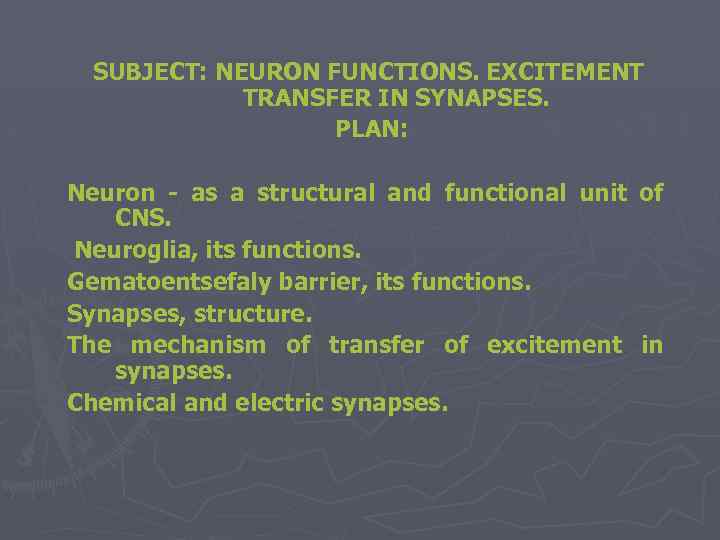
SUBJECT: NEURON FUNCTIONS. EXCITEMENT TRANSFER IN SYNAPSES. PLAN: Neuron - as a structural and functional unit of CNS. Neuroglia, its functions. Gematoentsefaly barrier, its functions. Synapses, structure. The mechanism of transfer of excitement in synapses. Chemical and electric synapses.
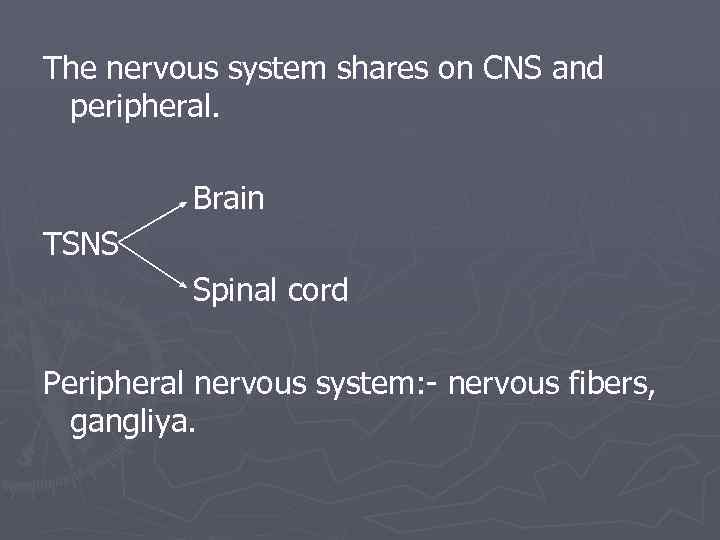
The nervous system shares on CNS and peripheral. Brain TSNS Spinal cord Peripheral nervous system: - nervous fibers, gangliya.
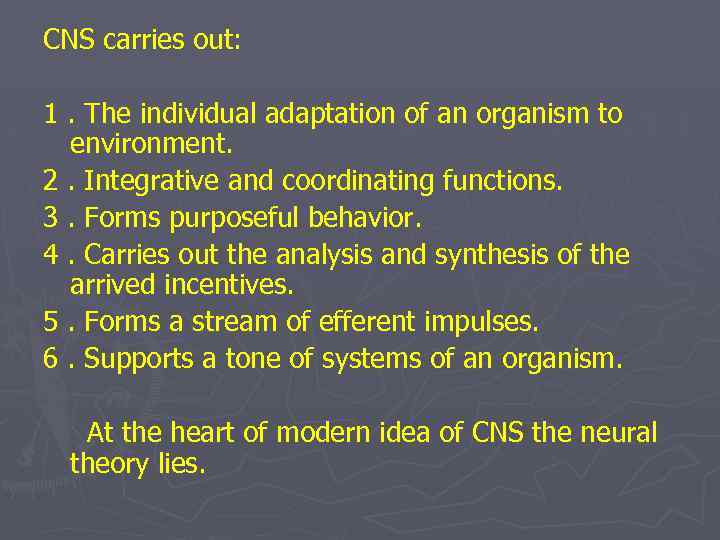
CNS carries out: 1. The individual adaptation of an organism to environment. 2. Integrative and coordinating functions. 3. Forms purposeful behavior. 4. Carries out the analysis and synthesis of the arrived incentives. 5. Forms a stream of efferent impulses. 6. Supports a tone of systems of an organism. At the heart of modern idea of CNS the neural theory lies.
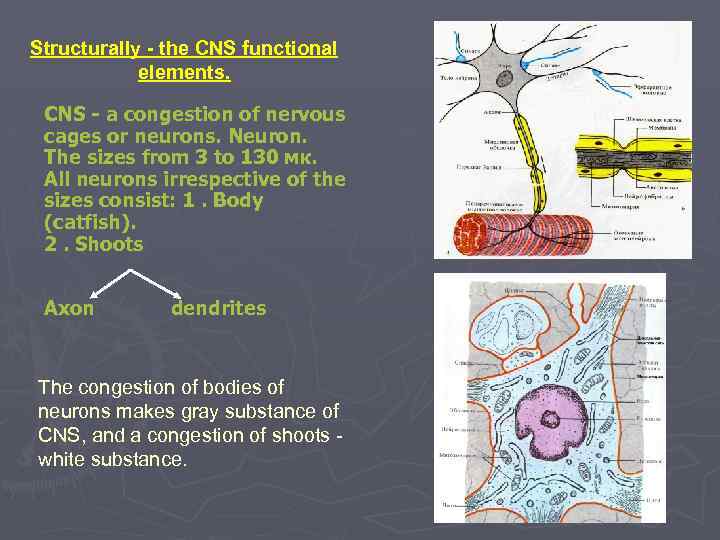
Structurally - the CNS functional elements. CNS - a congestion of nervous cages or neurons. Neuron. The sizes from 3 to 130 мк. All neurons irrespective of the sizes consist: 1. Body (catfish). 2. Shoots Axon dendrites The congestion of bodies of neurons makes gray substance of CNS, and a congestion of shoots white substance.
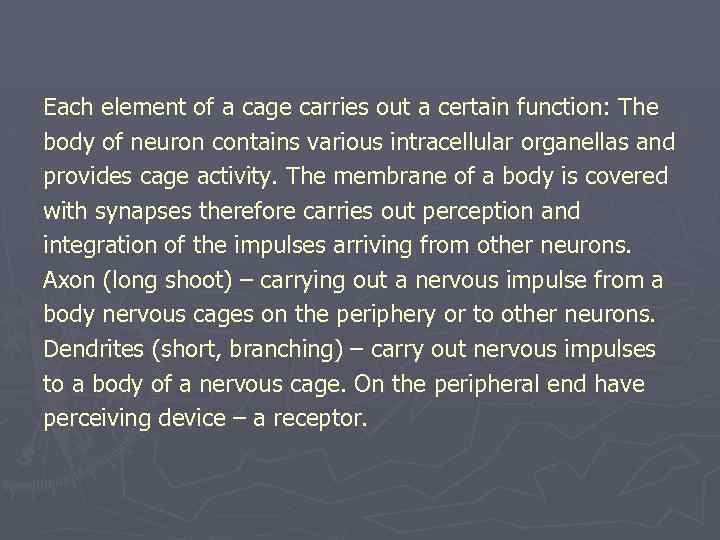
Each element of a cage carries out a certain function: The body of neuron contains various intracellular organellas and provides cage activity. The membrane of a body is covered with synapses therefore carries out perception and integration of the impulses arriving from other neurons. Axon (long shoot) – carrying out a nervous impulse from a body nervous cages on the periphery or to other neurons. Dendrites (short, branching) – carry out nervous impulses to a body of a nervous cage. On the peripheral end have perceiving device – a receptor.
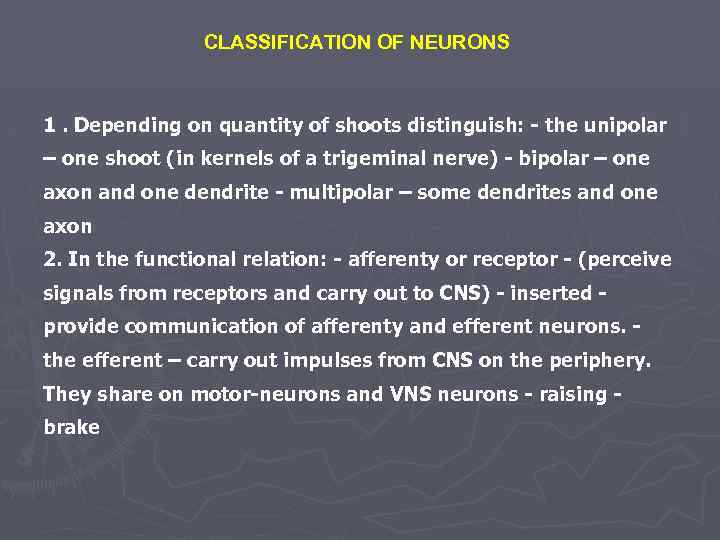
CLASSIFICATION OF NEURONS 1. Depending on quantity of shoots distinguish: - the unipolar – one shoot (in kernels of a trigeminal nerve) - bipolar – one axon and one dendrite - multipolar – some dendrites and one axon 2. In the functional relation: - afferenty or receptor - (perceive signals from receptors and carry out to CNS) - inserted provide communication of afferenty and efferent neurons. the efferent – carry out impulses from CNS on the periphery. They share on motor-neurons and VNS neurons - raising brake
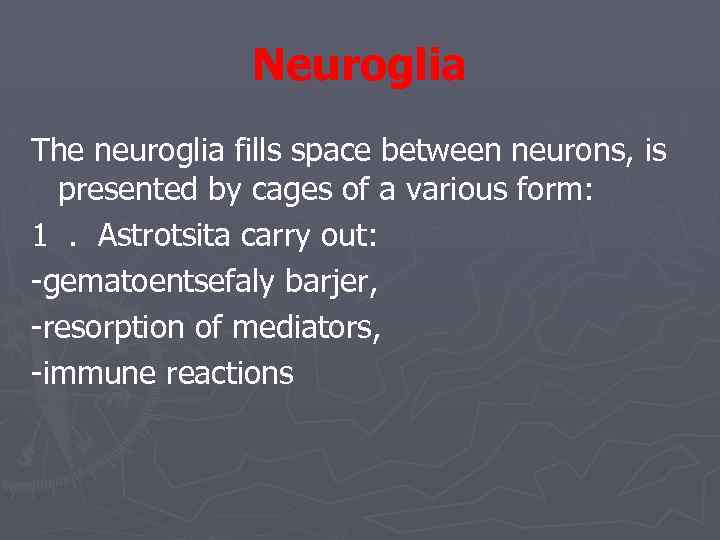
Neuroglia The neuroglia fills space between neurons, is presented by cages of a various form: 1. Astrotsita carry out: -gematoentsefaly barjer, -resorption of mediators, -immune reactions
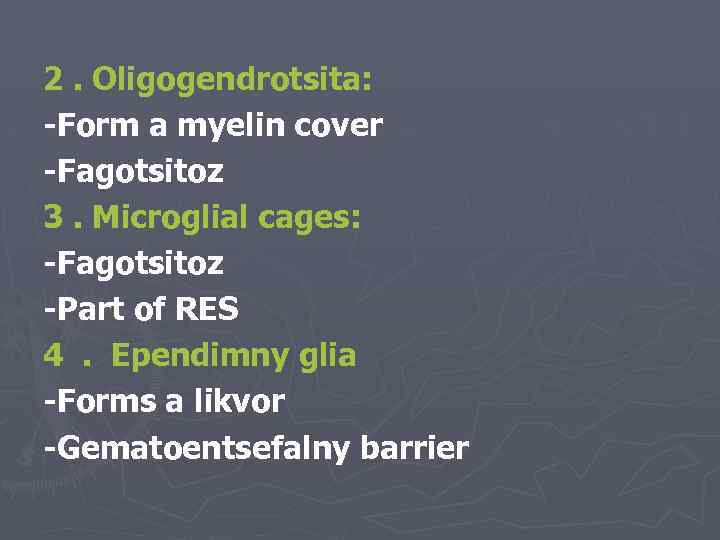
2. Oligogendrotsita: -Form a myelin cover -Fagotsitoz 3. Microglial cages: -Fagotsitoz -Part of RES 4. Ependimny glia -Forms a likvor -Gematoentsefalny barrier
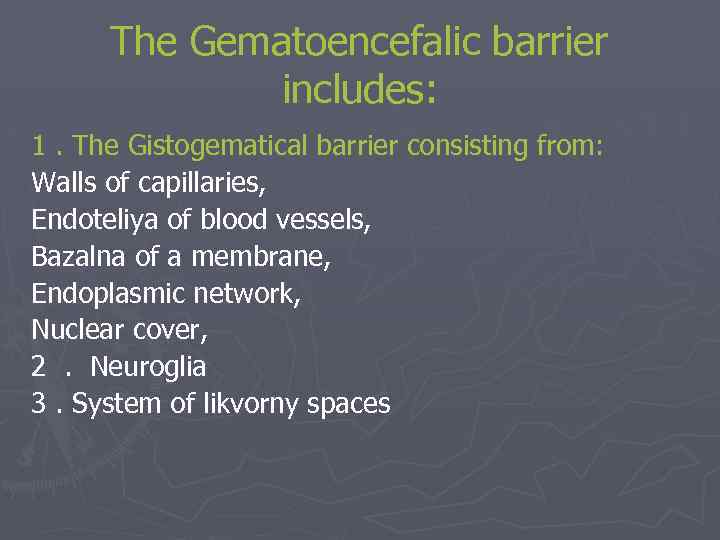
The Gematoencefalic barrier includes: 1. The Gistogematical barrier consisting from: Walls of capillaries, Endoteliya of blood vessels, Bazalna of a membrane, Endoplasmic network, Nuclear cover, 2. Neuroglia 3. System of likvorny spaces
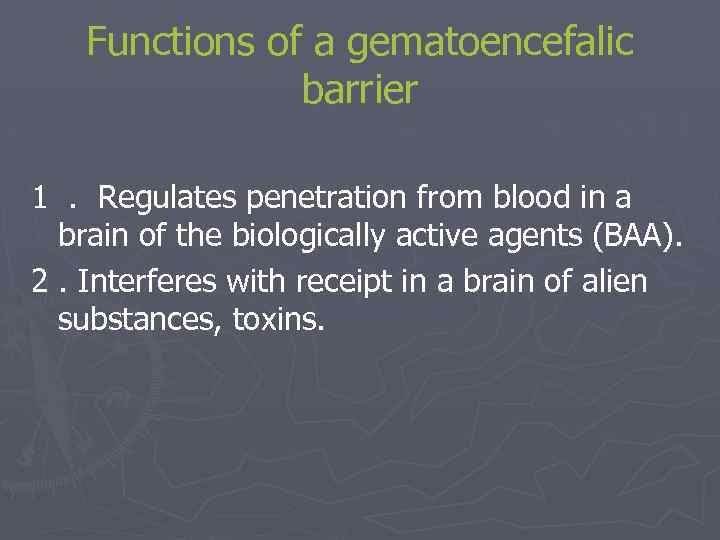
Functions of a gematoencefalic barrier 1. Regulates penetration from blood in a brain of the biologically active agents (BAA). 2. Interferes with receipt in a brain of alien substances, toxins.
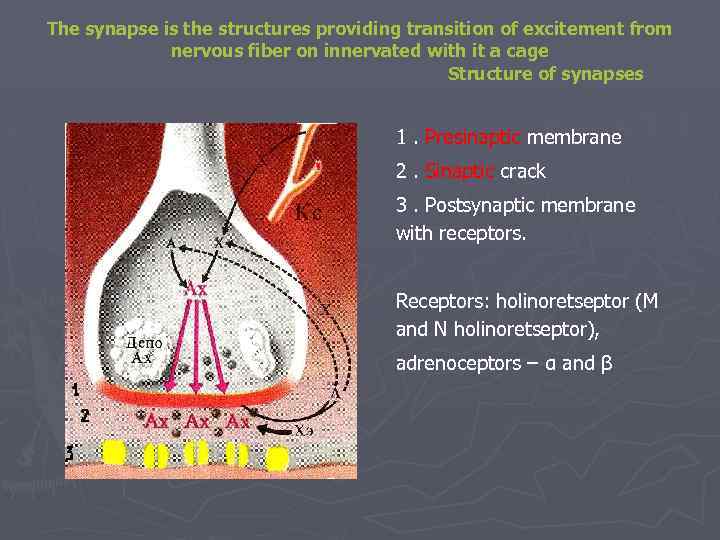
The synapse is the structures providing transition of excitement from nervous fiber on innervated with it a cage Structure of synapses 1. Presinaptic membrane 2. Sinaptic crack 3. Postsynaptic membrane with receptors. Receptors: holinoretseptor (M and N holinoretseptor), adrenoceptors – α and β

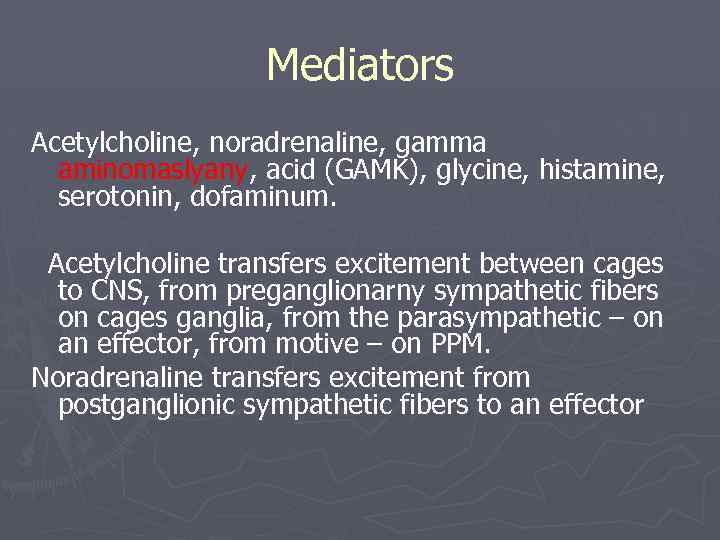
Mediators Acetylcholine, noradrenaline, gamma aminomaslyany, acid (GAMK), glycine, histamine, serotonin, dofaminum. Acetylcholine transfers excitement between cages to CNS, from preganglionarny sympathetic fibers on cages ganglia, from the parasympathetic – on an effector, from motive – on PPM. Noradrenaline transfers excitement from postganglionic sympathetic fibers to an effector
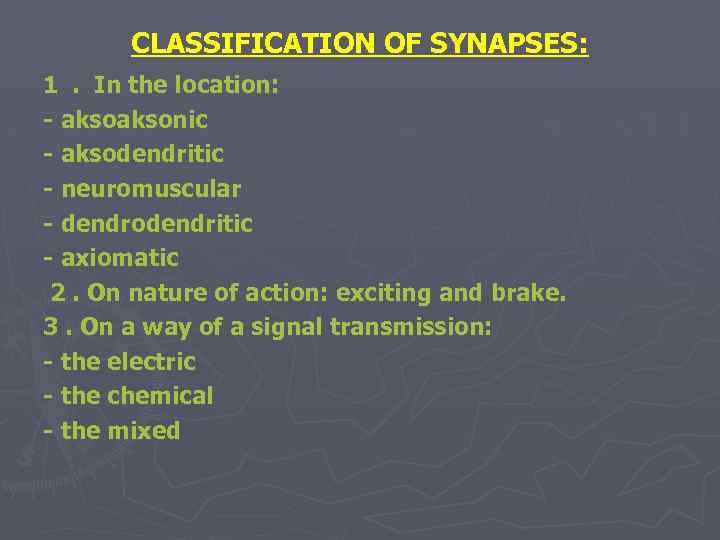
CLASSIFICATION OF SYNAPSES: 1. In the location: - aksonic - aksodendritic - neuromuscular - dendrodendritic - axiomatic 2. On nature of action: exciting and brake. 3. On a way of a signal transmission: - the electric - the chemical - the mixed
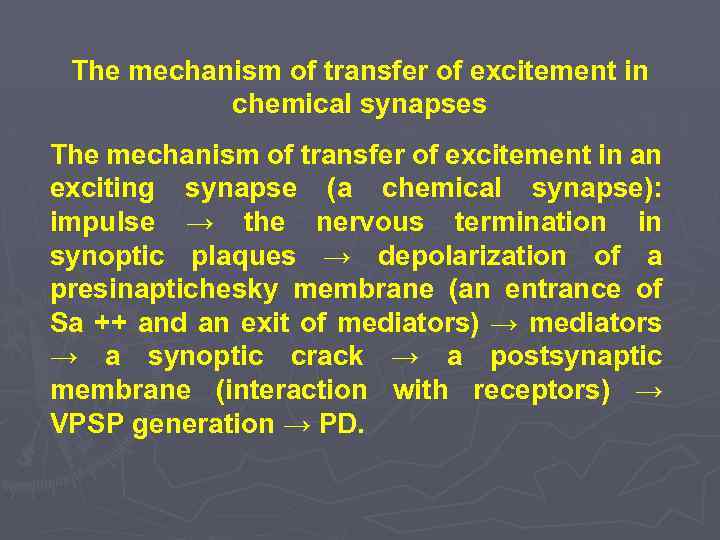
The mechanism of transfer of excitement in chemical synapses The mechanism of transfer of excitement in an exciting synapse (a chemical synapse): impulse → the nervous termination in synoptic plaques → depolarization of a presinaptichesky membrane (an entrance of Sa ++ and an exit of mediators) → mediators → a synoptic crack → a postsynaptic membrane (interaction with receptors) → VPSP generation → PD.

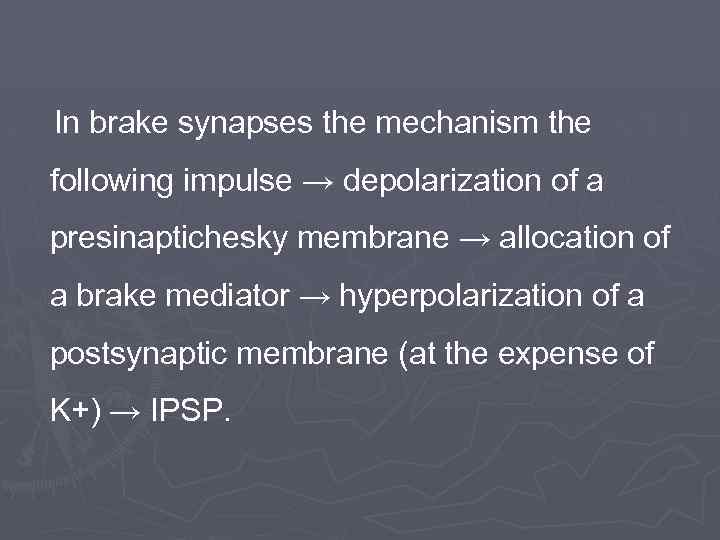
In brake synapses the mechanism the following impulse → depolarization of a presinaptichesky membrane → allocation of a brake mediator → hyperpolarization of a postsynaptic membrane (at the expense of K+) → IPSP.

PHYSIOLOGICAL PROPERTIES OF CHEMICAL SYNAPSES: 1. Excitement is transferred by means of mediators. 2. Possess unilateral carrying out excitement. 3. Fast fatigue (exhaustion of stocks of a mediator). 4. Low lability 100 -125 imp. / sec. 5. Summation of excitement 6. beating of a way 7. Sinaptic delay (0, 2 -0, 5 m/s). 8. Selective sensitivity to pharmacological and biological substances. 9. Are sensitive to temperature changes. 10. There is a trace depolarization.
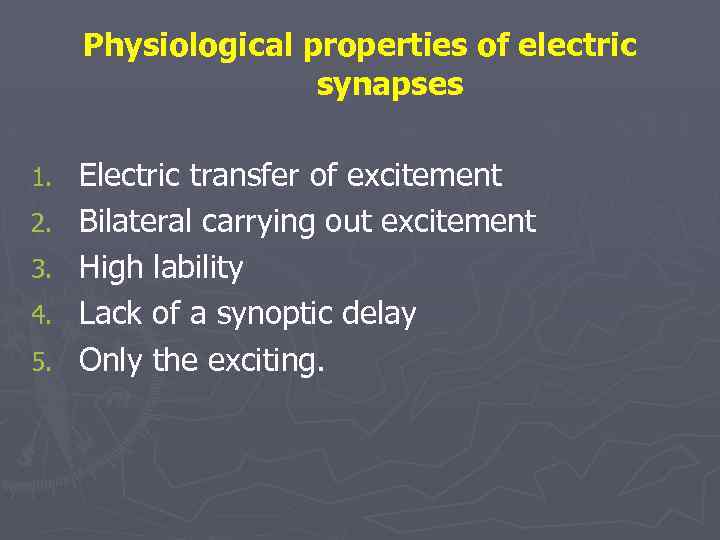
Physiological properties of electric synapses 1. 2. 3. 4. 5. Electric transfer of excitement Bilateral carrying out excitement High lability Lack of a synoptic delay Only the exciting.
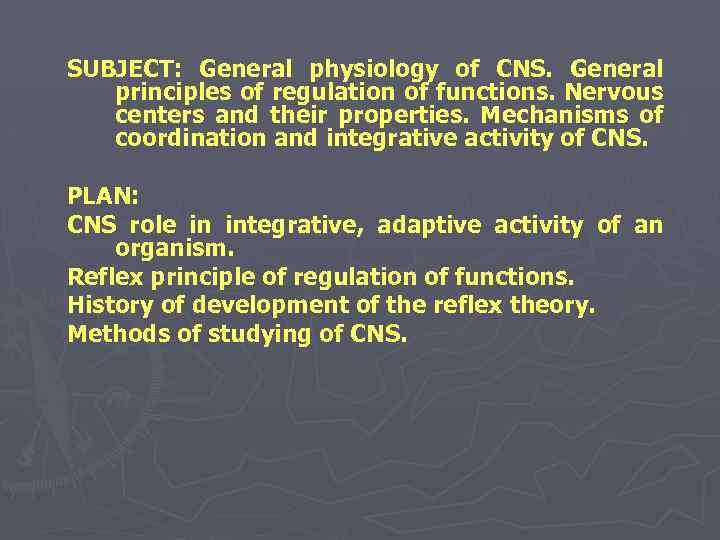
SUBJECT: General physiology of CNS. General principles of regulation of functions. Nervous centers and their properties. Mechanisms of coordination and integrative activity of CNS. PLAN: CNS role in integrative, adaptive activity of an organism. Reflex principle of regulation of functions. History of development of the reflex theory. Methods of studying of CNS.
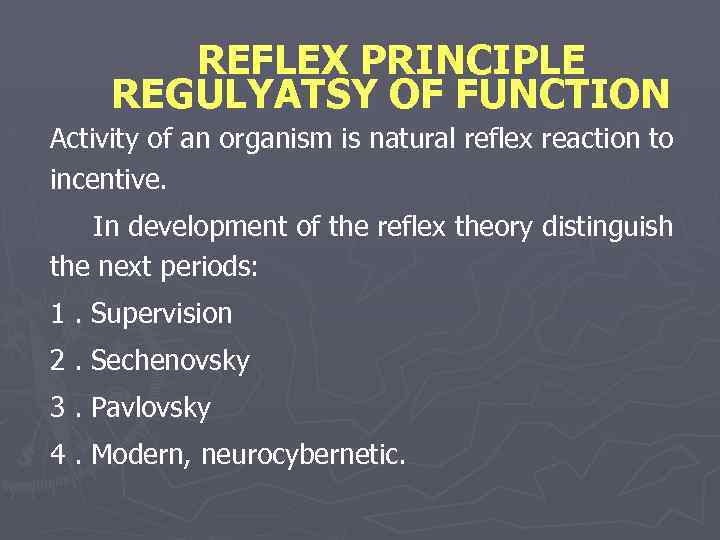
REFLEX PRINCIPLE REGULYATSY OF FUNCTION Activity of an organism is natural reflex reaction to incentive. In development of the reflex theory distinguish the next periods: 1. Supervision 2. Sechenovsky 3. Pavlovsky 4. Modern, neurocybernetic.
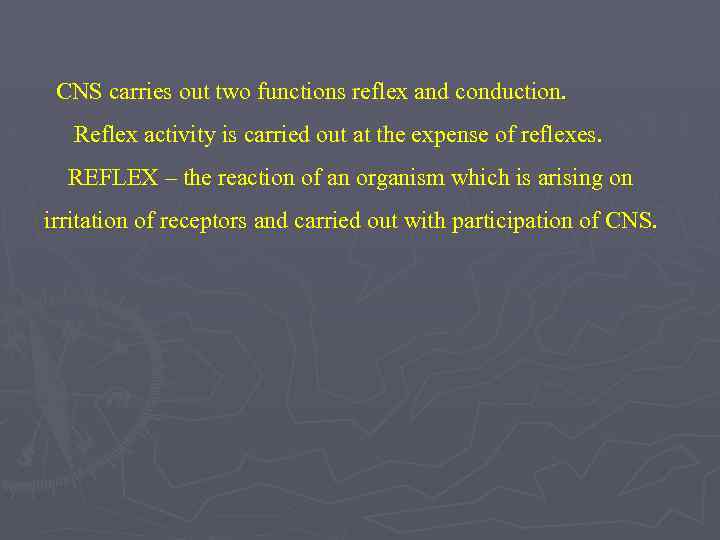
CNS carries out two functions reflex and conduction. Reflex activity is carried out at the expense of reflexes. REFLEX – the reaction of an organism which is arising on irritation of receptors and carried out with participation of CNS.
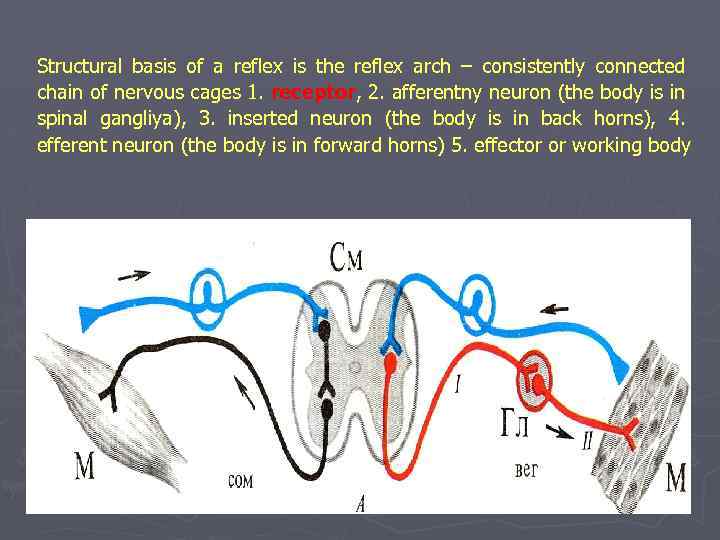
Structural basis of a reflex is the reflex arch – consistently connected chain of nervous cages 1. receptor, 2. afferentny neuron (the body is in receptor spinal gangliya), 3. inserted neuron (the body is in back horns), 4. efferent neuron (the body is in forward horns) 5. effector or working body
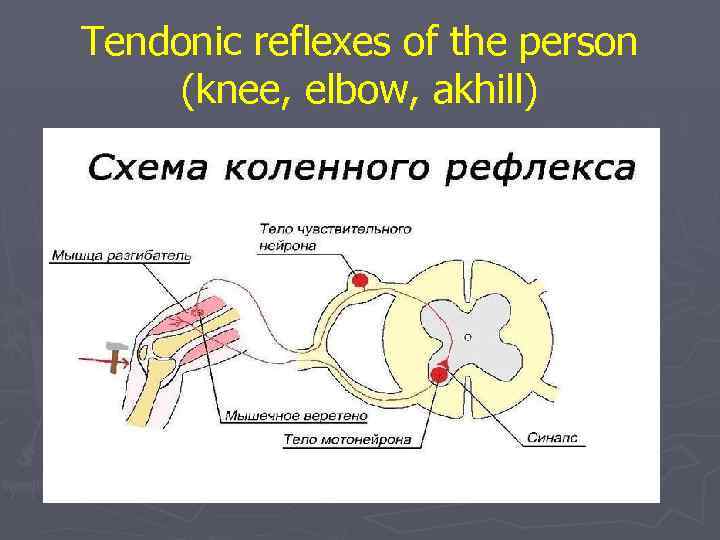
Tendonic reflexes of the person (knee, elbow, akhill)
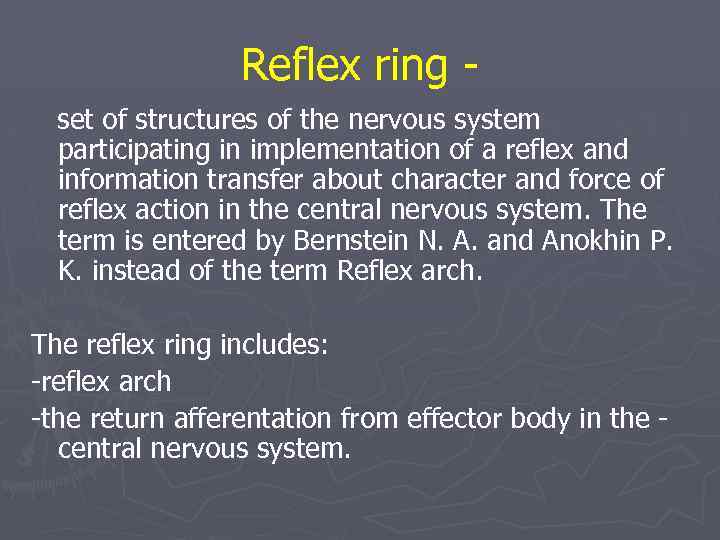
Reflex ring set of structures of the nervous system participating in implementation of a reflex and information transfer about character and force of reflex action in the central nervous system. The term is entered by Bernstein N. A. and Anokhin P. K. instead of the term Reflex arch. The reflex ring includes: -reflex arch -the return afferentation from effector body in the central nervous system.
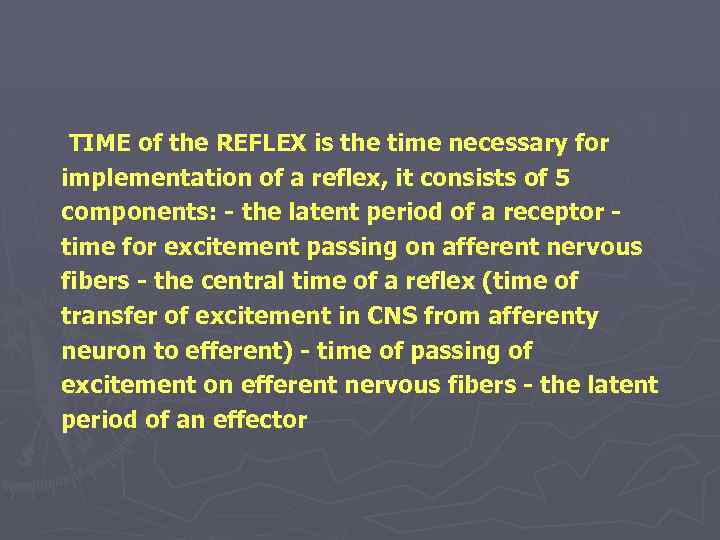
TIME of the REFLEX is the time necessary for implementation of a reflex, it consists of 5 components: - the latent period of a receptor time for excitement passing on afferent nervous fibers - the central time of a reflex (time of transfer of excitement in CNS from afferenty neuron to efferent) - time of passing of excitement on efferent nervous fibers - the latent period of an effector
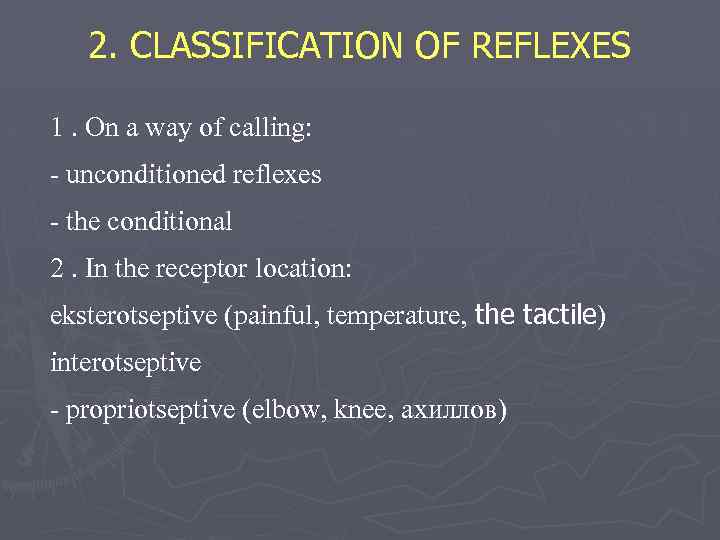
2. CLASSIFICATION OF REFLEXES 1. On a way of calling: - unconditioned reflexes - the conditional 2. In the receptor location: eksterotseptive (painful, temperature, the tactile) interotseptive - propriotseptive (elbow, knee, ахиллов)

3. Depending on an arrangement of the centers - the spinal - the bulbary - mezentsefalic - dientsefalic - Cortical
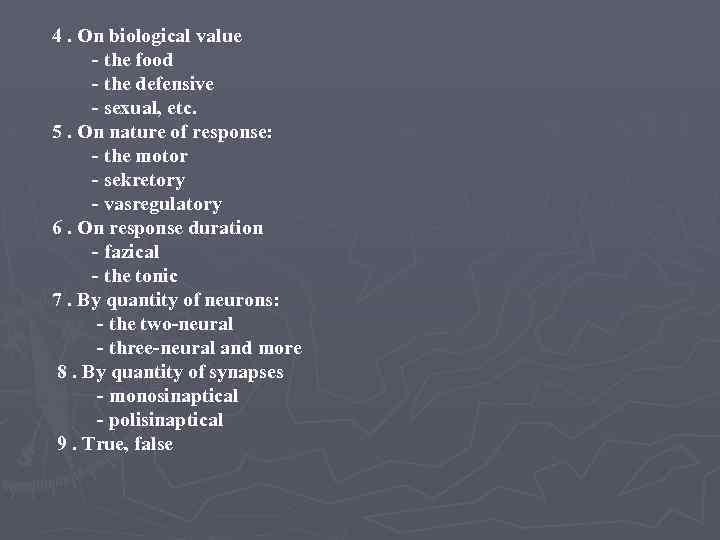
4. On biological value - the food - the defensive - sexual, etc. 5. On nature of response: - the motor - sekretory - vasregulatory 6. On response duration - fazical - the tonic 7. By quantity of neurons: - the two-neural - three-neural and more 8. By quantity of synapses - monosinaptical - polisinaptical 9. True, false
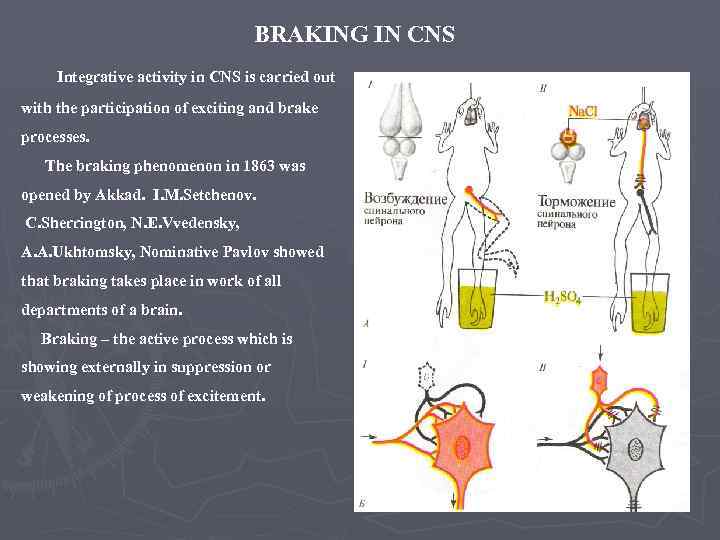
BRAKING IN CNS Integrative activity in CNS is carried out with the participation of exciting and brake processes. The braking phenomenon in 1863 was opened by Akkad. I. M. Setchenov. C. Sherrington, N. E. Vvedensky, A. A. Ukhtomsky, Nominative Pavlov showed that braking takes place in work of all departments of a brain. Braking – the active process which is showing externally in suppression or weakening of process of excitement.
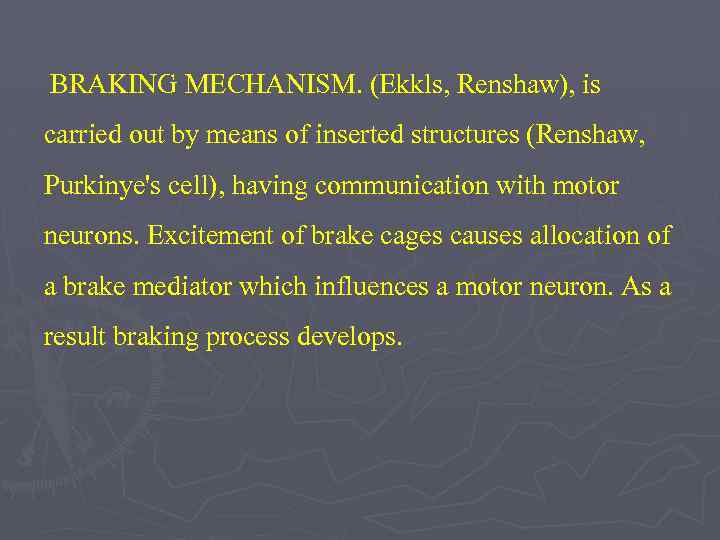
BRAKING MECHANISM. (Ekkls, Renshaw), is carried out by means of inserted structures (Renshaw, Purkinye's cell), having communication with motor neurons. Excitement of brake cages causes allocation of a brake mediator which influences a motor neuron. As a result braking process develops.
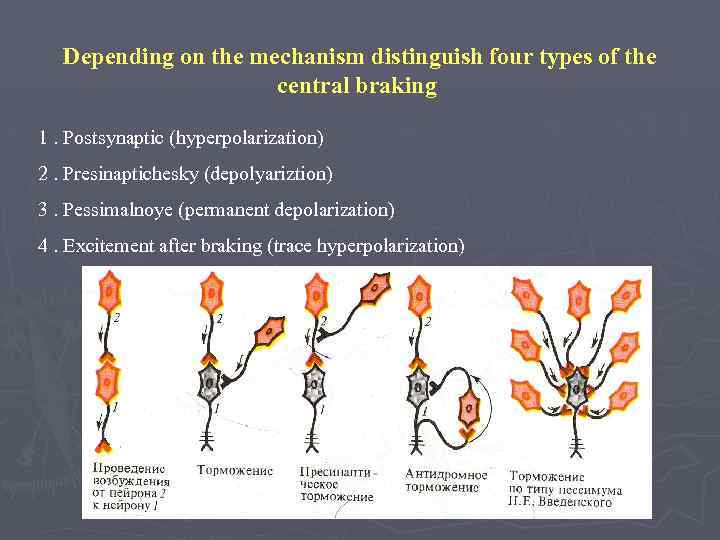
Depending on the mechanism distinguish four types of the central braking 1. Postsynaptic (hyperpolarization) 2. Presinaptichesky (depolyariztion) 3. Pessimalnoye (permanent depolarization) 4. Excitement after braking (trace hyperpolarization)

► The Presinaptichesky – a morphological substratum is aksonic the synapse in which the mediator is allocated and causes permanent long depolarization. ► Its reasons: ► Katodichesky depression ► Slow depolarization blocks permeability of a membrane for sodium ions, strengthening work sodium - potassium ATP-elements.
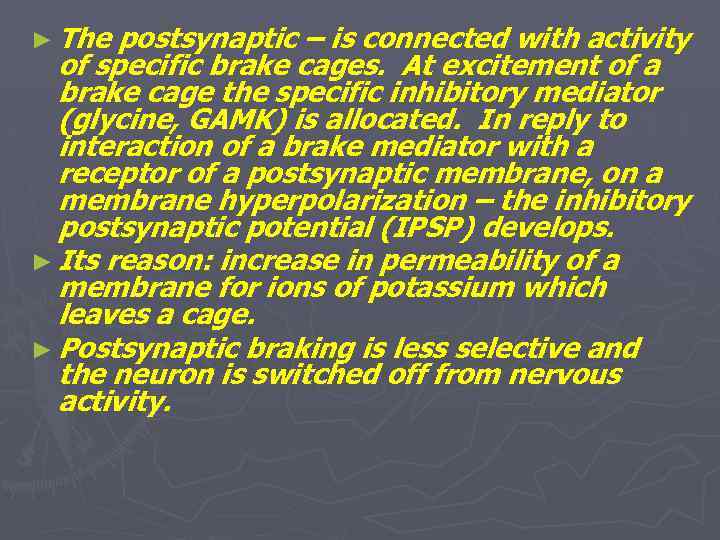
► The postsynaptic – is connected with activity of specific brake cages. At excitement of a brake cage the specific inhibitory mediator (glycine, GAMK) is allocated. In reply to interaction of a brake mediator with a receptor of a postsynaptic membrane, on a membrane hyperpolarization – the inhibitory postsynaptic potential (IPSP) develops. ► Its reason: increase in permeability of a membrane for ions of potassium which leaves a cage. ► Postsynaptic braking is less selective and the neuron is switched off from nervous activity.
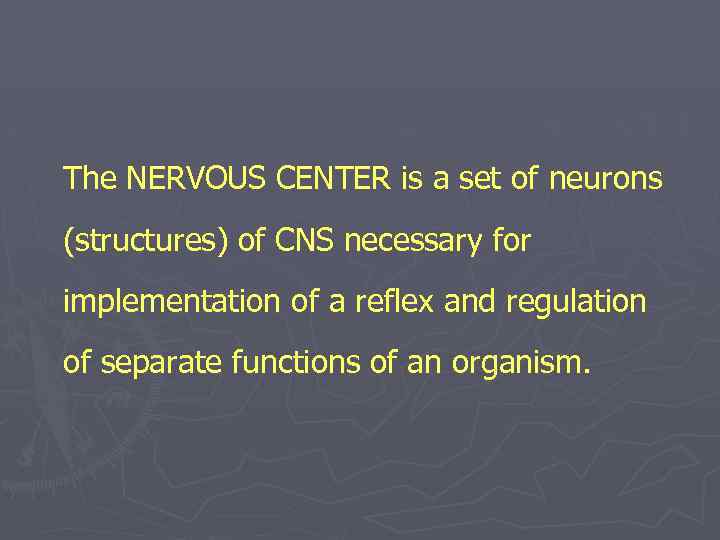
The NERVOUS CENTER is a set of neurons (structures) of CNS necessary for implementation of a reflex and regulation of separate functions of an organism.
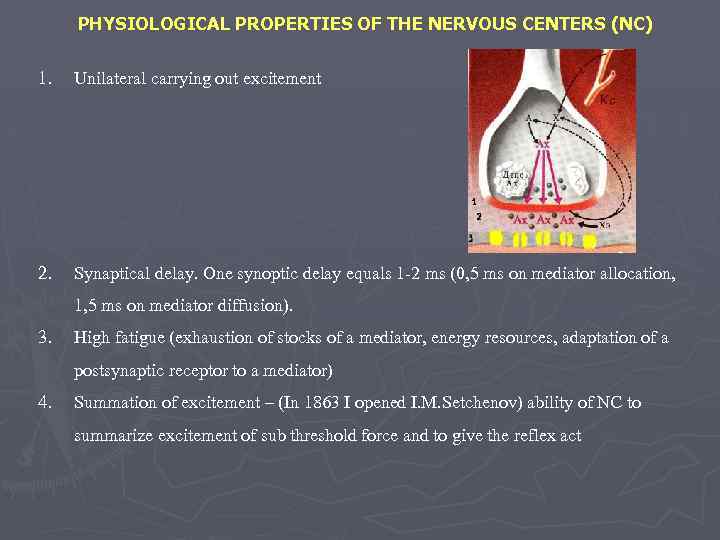
PHYSIOLOGICAL PROPERTIES OF THE NERVOUS CENTERS (NC) 1. Unilateral carrying out excitement 2. Synaptical delay. One synoptic delay equals 1 -2 ms (0, 5 ms on mediator allocation, 1, 5 ms on mediator diffusion). 3. High fatigue (exhaustion of stocks of a mediator, energy resources, adaptation of a postsynaptic receptor to a mediator) 4. Summation of excitement – (In 1863 I opened I. M. Setchenov) ability of NC to summarize excitement of sub threshold force and to give the reflex act

Distinguish two types of a summation: - the spatial - temporary

5. Convergence – a convergence of impulses of a different modality on the same nervous centers. Distinguish the following types of convergence: - the multitouch - the multibiological - the touch and biological - aksonalsensoric
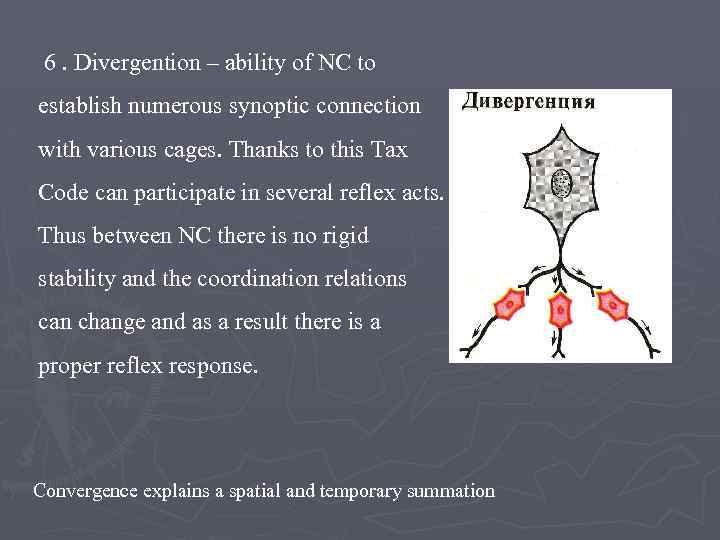
6. Divergention – ability of NC to establish numerous synoptic connection with various cages. Thanks to this Tax Code can participate in several reflex acts. Thus between NC there is no rigid stability and the coordination relations can change and as a result there is a proper reflex response. Convergence explains a spatial and temporary summation

7. Okklyuziya - "obstruction". Have partially blocked receptive fields. Nervous centers 8. The suppression – total reaction is higher than the arithmetic sum of reaction at the isolated lower 9. Transformation of a rhythm and power of incentive 10. After-effect (reaction continuation after the irritation termination) - short-term (trace depolarization) - the long – circulation of impulses on the closed neural chains.
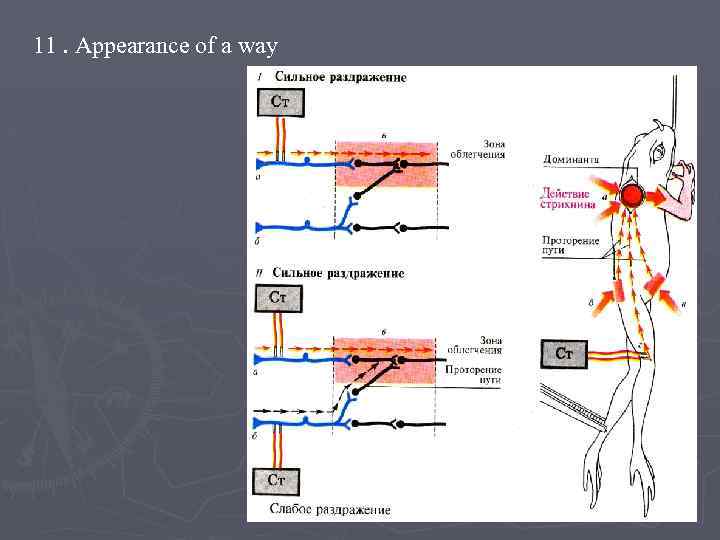
11. Appearance of a way
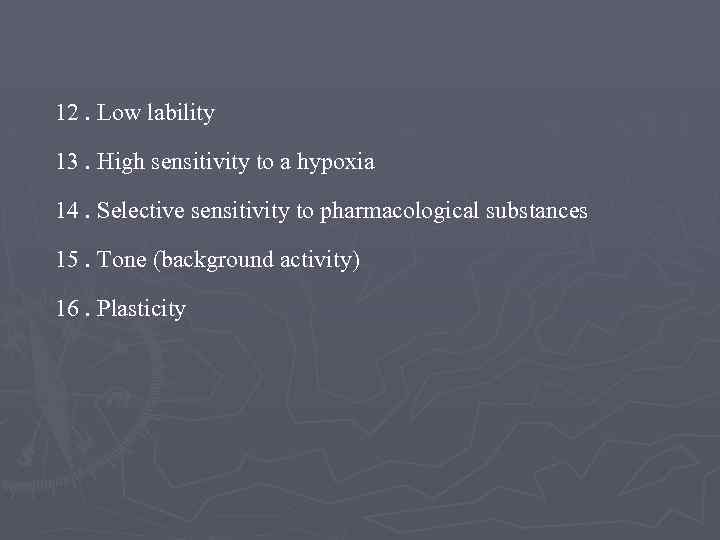
12. Low lability 13. High sensitivity to a hypoxia 14. Selective sensitivity to pharmacological substances 15. Tone (background activity) 16. Plasticity
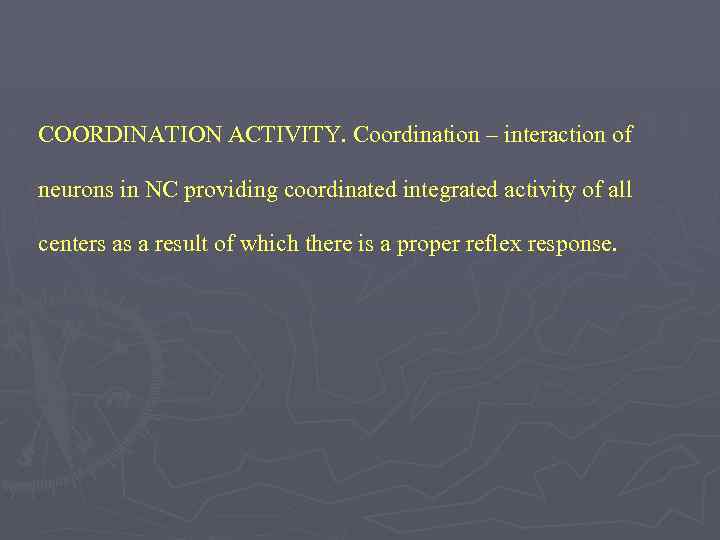
COORDINATION ACTIVITY. Coordination – interaction of neurons in NC providing coordinated integrated activity of all centers as a result of which there is a proper reflex response.
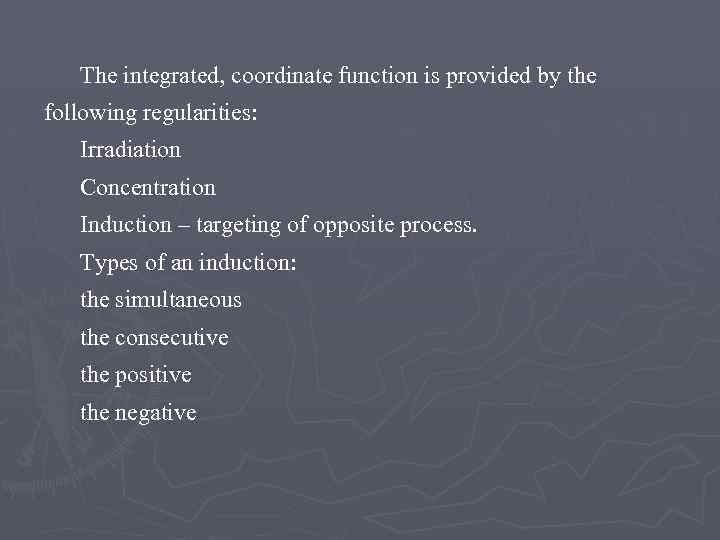
The integrated, coordinate function is provided by the following regularities: Irradiation Concentration Induction – targeting of opposite process. Types of an induction: the simultaneous the consecutive the positive the negative
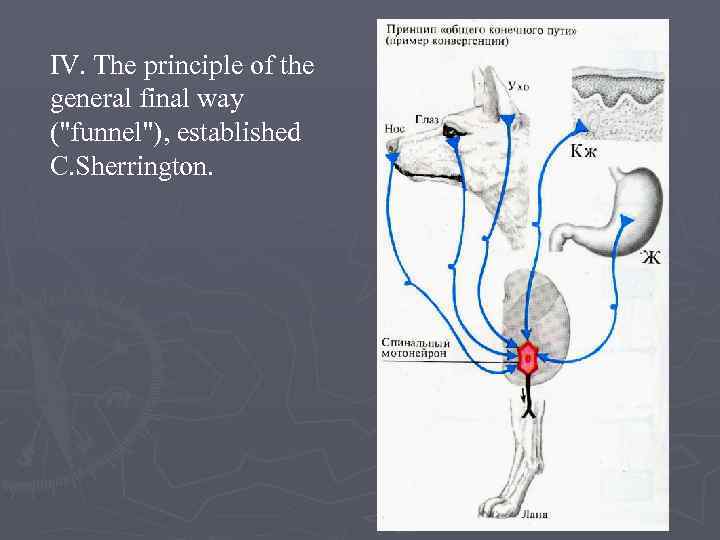
IV. The principle of the general final way ("funnel"), established C. Sherrington.
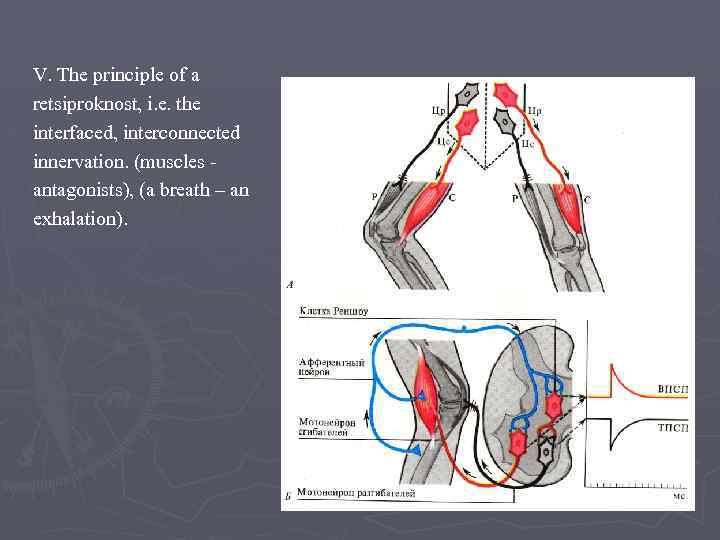
V. The principle of a retsiproknost, i. e. the interfaced, interconnected innervation. (muscles antagonists), (a breath – an exhalation).
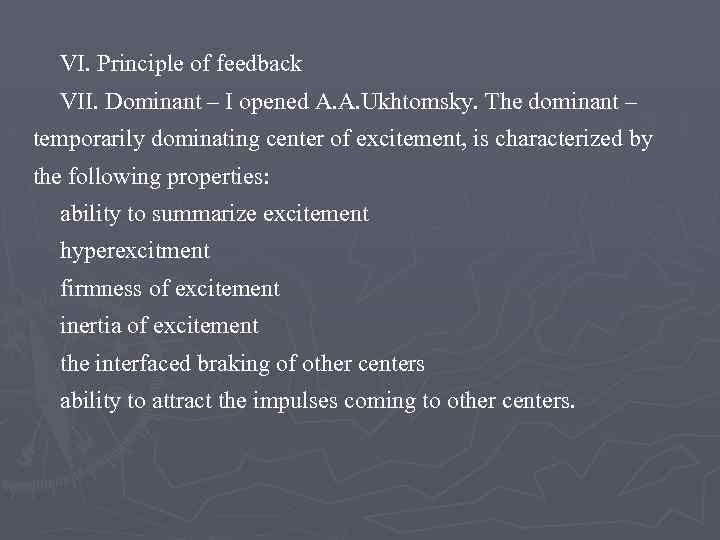
VI. Principle of feedback VII. Dominant – I opened A. A. Ukhtomsky. The dominant – temporarily dominating center of excitement, is characterized by the following properties: ability to summarize excitement hyperexcitment firmness of excitement inertia of excitement the interfaced braking of other centers ability to attract the impulses coming to other centers.
4- Нейрон. Метод. иссл. ЦНС. Синапсы.ppt